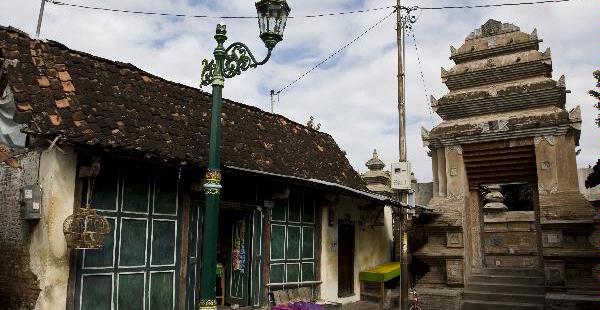Kotagede also known as Pasar Gede is an area in the Indonesian city of Yogyakarta. One of the old capitals of Mataram, the area now has an archaeological site which contains the remains of the kraton (palace), the royal cemetery, and royal mosque of Mataram, dated from the late 16th and early 17th centuries.
The honorable name of this location in a higher and more respectful level of Javanese language (Kromo) is Pasar Gede.
There are many legends and local tales connects the site to the Mataram palace, however much of the physical remnants of the palace and the capital city are already destroyed. The only parts that remains quite intact are the Kota Gede royal mosque, the royal cemetery (precursor to Imogiri), and a few sections of the original palace walls.
The city lost its prestige when the center of power was shifted to Kartasura near modern Surakarta. The city further lost its political and cultural significance after replaced by Imogiri as the royal cemetery for the sultanates. Later sultanate of Mataram was split between Yogyakarta Sultanate and Surakarta.
The Royal Graveyard holds important graves that trace connections of Mataram with earlier kingdoms, and the placement of the graves within the covered area of the graveyard can be considered as a physical representation of 'silsilah' or genealogy of the rulers and their progenitors. It is guarded and maintained by Juru Kunci who are employed by the two palaces of Yogyakarta and Surakarta.
In mid-twentieth century, Kota Gede became synonymous with silverworks and silver handicrafts, since the area has become the home of silversmith in Yogyakarta. At the time of Indonesian independence in the 1940s, and after considerable promotion and publicity to the silverworks within this locality, Kota Gede gain popularity as the center of Javanese silver handicraft.
During the expansion of Yogyakarta city in the late twentieth century, Kota Gede was absorbed into Yogyakarta and has become merely a suburb within the city.
The honorable name of this location in a higher and more respectful level of Javanese language (Kromo) is Pasar Gede.
There are many legends and local tales connects the site to the Mataram palace, however much of the physical remnants of the palace and the capital city are already destroyed. The only parts that remains quite intact are the Kota Gede royal mosque, the royal cemetery (precursor to Imogiri), and a few sections of the original palace walls.
The city lost its prestige when the center of power was shifted to Kartasura near modern Surakarta. The city further lost its political and cultural significance after replaced by Imogiri as the royal cemetery for the sultanates. Later sultanate of Mataram was split between Yogyakarta Sultanate and Surakarta.
In mid-twentieth century, Kota Gede became synonymous with silverworks and silver handicrafts, since the area has become the home of silversmith in Yogyakarta. At the time of Indonesian independence in the 1940s, and after considerable promotion and publicity to the silverworks within this locality, Kota Gede gain popularity as the center of Javanese silver handicraft.
During the expansion of Yogyakarta city in the late twentieth century, Kota Gede was absorbed into Yogyakarta and has become merely a suburb within the city.









